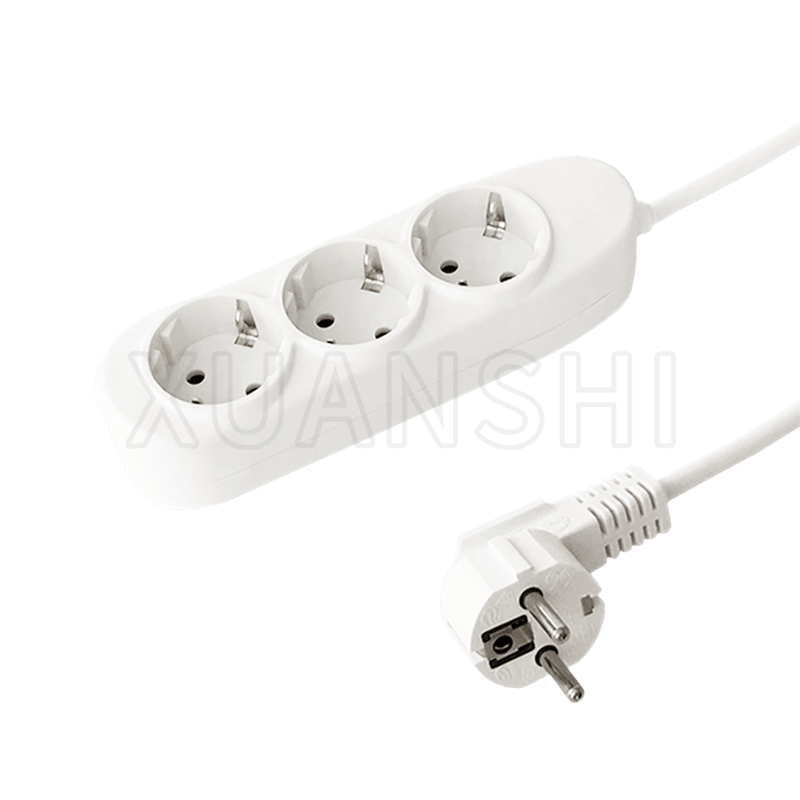The specific method and effectiveness of overcurrent protection in a 3 way power strip can vary depending on the manufacturer and model.Here is a general overview of how such devices typically implement overcurrent protection:
1.Circuit Breakers: Many 3 way power strips are equipped with individual circuit breakers for each outlet or a single circuit breaker for all outlets combined. These circuit breakers are designed to trip and disconnect power if the current flowing through them exceeds a certain threshold. This threshold is typically rated in amperes (Amps) and is chosen to protect the wiring and connected devices from overheating and potential fire hazards.
2.Resettable Circuit Breakers: Some power strips feature resettable circuit breakers, also known as thermal circuit breakers or overload protectors. These breakers automatically reset after the overcurrent condition is resolved. This means that if a short circuit or overload occurs, the breaker will trip and disconnect power, but once the issue is resolved (e.g., by unplugging a faulty device), the user can reset the breaker to restore power to the outlets.
3.Surge Protection and Overcurrent: In some power strips, overcurrent protection may be integrated with surge protection. Surge protectors can detect and respond to voltage spikes and surges that can occur during electrical storms or due to power grid fluctuations. Some surge protectors also incorporate overcurrent protection features to safeguard against excessive current draw.
4.LED Indicators: Many power strips include LED indicators to provide a visual indication of the status of each outlet's overcurrent protection. These indicators may change color or illuminate when the protection has been triggered.
5.Rating and Testing: It's essential to check the manufacturer's specifications and user manual for the power strip to understand the exact overcurrent protection rating and testing procedures. Manufacturers typically provide guidelines on what types of loads and conditions the power strip can safely handle.
6.Response Time: A fast response time is crucial for effective overcurrent protection. When the current through the power strip exceeds the predetermined threshold, the circuit breaker or overcurrent protection mechanism should trip almost immediately. This rapid response prevents the wiring and connected devices from being subjected to prolonged high currents, reducing the risk of overheating and fire.
7.Manual Reset: Power strips with manual reset buttons for their circuit breakers require the user to take action after an overcurrent event. Once the circuit breaker trips, the user must physically reset it by pressing the reset button. This ensures that the user is aware of the problem and takes corrective action, adding an extra layer of safety.
8.Coordination with Surge Protection: Surge protectors and overcurrent protection mechanisms can complement each other in a power strip. Surge protection guards against voltage spikes and transient surges, while overcurrent protection focuses on excessive current flow. The coordination of these features ensures comprehensive protection, safeguarding devices from both voltage and current-related issues.
9.Application Considerations: The choice of a power strip should align with its intended application. Different environments have varying requirements for overcurrent protection. For example, a power strip used in a home office may have different specifications than one used in an industrial setting. It's essential to select a power strip that meets the specific needs and safety standards of the intended environment.
10.User Education: Manufacturers often provide user manuals and guidelines for using the power strip safely. It's crucial to educate users or employees about these instructions, emphasizing the importance of not bypassing or disabling overcurrent protection features. User awareness is a key factor in maintaining safety.
11.Visual or Audible Alarms: Some advanced power strips include visual or audible alarms that activate when the overcurrent protection is triggered. These alarms serve as immediate alerts to users, indicating that there is an issue that requires attention. Visual alarms may include LED indicators that change color, while audible alarms emit a sound when tripped.
12.Compatibility with GFCI Outlets: In environments where Ground Fault Circuit Interrupter (GFCI) outlets are present, it's essential to ensure that the power strip is compatible. Some power strips are designed to work seamlessly with GFCI outlets, providing enhanced safety by coordinating protection features.
Wiring: H05VV-F 3G1.0/1.5mm²
Applicable Standards: Max.3500W
Product Certification: CE/TUV GS
Can it be Customized: yes
Whether To Provide Free Samples: yes
